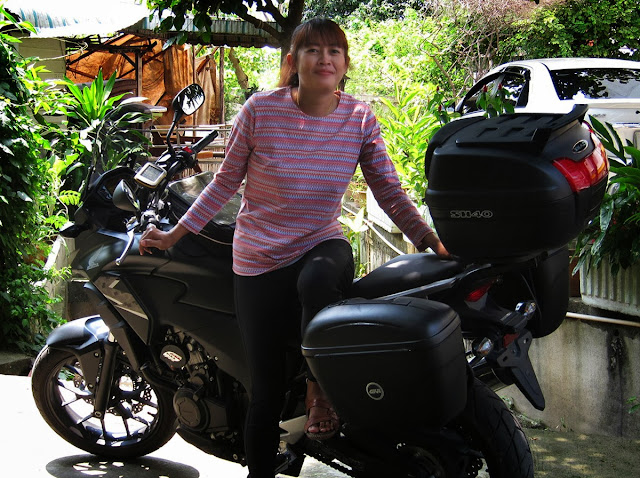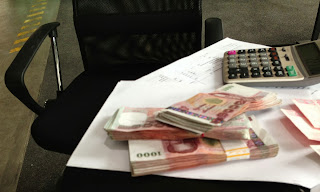September 24, 2013 — Chiang Mai, Thailand
Today is my 70th birthday and I'm glad to report that my life is going well. The heart surgery is in the past and the future is looking rosy from my vantage point here in northern Thailand. I'm busy, counting myself lucky to be alive and in such good health, riding my new motorcycle, and enjoying Thailand and my lovely friend and companion, Nut. I look back at the years leading up to this birthday and know I could never have planned for my life to turn out this way. Happy Birthday to me!
I've been trying to write this post for a few days but, as always, the OSM mapping projects I so enjoy consume most of my desk time. I've been working & riding in the area north of Lampang lately. A look at the existing OSM of that region convinced me that there was a lot of exploring, and mapping work, to be done over there. We've made two day trips in the past couple of weeks and they were lots of fun, especially because the new bike is so awesome. More on mapping in later posts. This one is about the bike...
 |
| Me and Nut aboard the CB500X |
The CB500X is an absolute dream. Regular readers know I loved my last bike, a 2011 Honda CBR250 that I drove 12,000 miles over the past two years, but this one is the bomb. Bigger and much more powerful, it makes driving these roads sheer pleasure, especially for a bloke my size and weight riding 2-up with my petite 110 lb girlfriend. I can cruise along at 3 or 4 thousand
RPM and when I twist the throttle, it gets up and goes. As an added bonus, it gets very respectable gas mileage. I'm running gasohol over here because it's quite a bit cheaper than gasoline ($4.60/gallon vs $5.40/gallon) and I've been getting roughly 70-75 mpg (30-32 km/liter). Not bad considering the CBR250 under generally similar conditions achieved an overall average of 78 mpg for the two years I drove it.
 |
| Mileage chart - CB500X |
The CB500 isn't a superbike by any means but there is no comparison between the high-revving, single-cylinder CBR and this bike. It runs smoothly at 2500
RPM in the upper gears, a level at which the CBR's engine would shake, rattle and balk unless you were in 1st or 2nd. If I want to overtake a slow moving vehicle I often don't need to downshift - 6th gear has enough torque to pull it off. The roads here make for some gorgeous motorcycling but one doesn't need the sheer horsepower required for freeway travel in the states. I usually travel at around 50-55 mph, an absolutely pokey pace compared to the normal speeds I maintained in the U.S. on the VStrom a couple of years ago. The other thing is that while the roads in Thailand are fairly decent, they aren't billiard table smooth like those stateside. Most of them are concrete and were paved the old fashioned way, by hand, and a bunch of guys with trowels simply cannot produce as smooth a surface as our fancy paving machines. Consequently, even the best roads in Thailand are a bit lumpy — traveling at 70 mph makes for a fairly jittery ride on most highways.

The biggest plus for me is the increased comfort the larger bike provides. The CB500X is the touring model and as such, allows a very upright posture. The long-travel front forks suck up the bumps very well and the rear shock is set perfectly for riding 2-up; it's a much nicer all around ride than we're used to. The seat is higher then the CBR and the entire bike is scaled up to where I can ride all day with no wrist fatigue. The stock seat is fairly comfortable too. Nut, who has on occasion been heard to utter the Thai phrase, เจ็บตูด jep dtùut (butt hurts), after rides on my other bikes, hasn't complained about this one (yet).
As I was browsing through my images I came across some I had from when I put my 650 cc VStrom up for sale back in 2011. I was struck by their similarities. Both are in matte black, both are mid-size twins, and both extremely comfortable for long distance riding. I recall when I was selling that bike after a lovely but frustrating (and cold) tour through the southwestern states that if not for the hefty import duties it would be a wonderful bike for Thailand. Fast forward and I now have almost the same bike except this one is lighter and quicker in traffic and through the turns.

I bought Givi (knock-offs) side cases so that when we tour we can take along enough gear to be comfortable. An added plus is that all the cases are lockable and lock to their mounts. I paid about $300 USD for them and a pair of extra loud PIAA horns, installed at CNX Motosport in Nong Hoi. (N18.75368 E99.00870). I had the guys at CNX mount the Shad top box I bought in Bangkok using a bracket made for the CB500 series that they also carry at their shop. We'd be lost without that top box. We use it to carry groceries and for safekeeping valuables while we're restauranting or shopping. All the boxes are waterproof too.
 |
| CB500 dash with my Garmin Montana in its mount |
The bike is powered by a smooth and lusty sounding DOHC 4-valve per cylinder, water cooled, 471cc parallel-twin engine. Either this 6-speed transmission shifts extra well or my handling of the clutch has improved radically over the past couple of years because this baby shifts sweeter than any bike I've ever driven. Honda did a great job with the CB500's stock exhaust as well because it produces a very mellow tone at all RPMs. I always get a kick out of the CBR250 owners willing to shell out 4 or 5 hundred bucks for a fancy carbon-fibre muffler in the forlorn hope that it'll make the little powerplant sound more like a big bike. (And here I am bragging up the sound of my 500cc. Boys and their toys - it never changes. LOL)
 |
| What 215,000 baht looks like |
The CB500X sells in Chiang Mai for 215K baht ($6,900 USD) with ABS. Apparently the ABS on this bike isn't the same as the "combined ABS" I had on the CBR but I hope I never need to learn the differences. It was fitted with Pirelli
Scorpion radial tires rather than the more common IRCs. Both are 17 inch wheels: rear 160/60, front 120/70. (See my
Notes below for more about tires.) The generous 4.5 gallon (17 liter) tank will get you 320-340 miles before filling up. Its speedometer, like all bikes I've tested, reads on the high side according to my GPS. This one is only 5% high whereas several Phantoms I've tested, my CBR250, my Suzuki VStrom all were off by +10%. That is, when the CB500X speedo reads 84 kph, you're really only going 80 kph. The odometer, on the other hand is fairly accurate. Go figure.
On the day I picked the bike up from Honda Big Wing the sales guy mentioned that he had a taller windscreen available for 1,500 baht ($45 USD), and did I want the last one in stock? Recalling the wind noise that plagued me on the VStrom tour I jumped at it. It was a great buy because with it the wind noise is quite acceptable — I don't feel the need to wear earplugs anymore. I reckon that's another reason this bike feels so much more comfortable than the CBR. I've had several inquiries on this blog about that screen and my dealer told me he got it from a local motorcycle accessory shop, Pekky Pro Superbike on Huai Kaew Road. I inquired at Pekky Pro and they told me it was made by an outfit called Ermax and that they get their stock from a wholesaler in Bangkok. A quick check on Google turned up half a dozen Ermax listings in several countries including the U.S. and Europe.
Oh, one more thing. In the topmost photo you might be able to see a gray colored vest under my jacket. No, I'm not wearing it because I'm cold but to help me stay cool. It's a cooling vest I bought on impulse at the Cyclegear shop in Springfield, Oregon, in July for $40 USD. I used it for the first time on one of those Lampang trips I mentioned. The day started out cloudy but later the sun came out strong and jacked the temp up to about 95 degrees — I thought, this is a perfect time to test my new vest. So I held it under water in a restroom sink until it got thoroughly soaked. It picked up what felt like 10 pounds of water and dripped hardly at all as I carried it outdoors to put it on. It must use some super absorbent filling because
it holds a lot of water. It worked like a charm. Evaporative cooling makes for some pretty good air conditioning at 50 mph. I was quite comfy in what Alaskans would term searing heat on the 2-hour ride home. I'll be wearing that guy a lot on those hot days next spring. Hell, I'll be packing it along on our ride tomorrow. You never know when the clouds will part and ol' man Sol will come out to knock you down a peg or two.
All in all, the new Honda is an excellent bike. If you're a Thailand rider and are looking for a made-in-Thailand bike that offers decent performance for a not outrageous price, excellent comfort and goo
d fuel economy, this bike more than fills the bill.
Note: April 2015: The stock Pirelli Scorpion tires ran for about 12K kilometers before they started looking thin. Replacements cost in the neighborhood of 13,000 baht so I opted for a cheaper version, Pirelli Rossas — about 10K baht for the set. Those are now needing to be replaced with about 29K kilometers on the clock. I don't push my luck and am not a fast driver so I really don't need a high performance tire with a soft sticky tread to get me through corners at the blazing speed of 65-70 kph. As IRC doesn't make a 160/60 tire,
I'm going to try to locate a set of made-in-Thailand Dunlops for my next go round.
The motor is running great, no issues at all. Other than the initial setting at 1,000 km, I have yet to adjust the valves or replace the spark plugs. The bike consistently gets 70-75 mpg (30-32 km/L) for mileage.
It's a lovely machine. After two full seasons, I am incredibly happy with it and think it is the perfect bike for Thailand.
Note: March 2017: I recently noticed that the new CB500X bikes are coming from the factory with Dunlop tires. I was interested to see if they cost less than 12-13K baht I've been paying up to now. I was in Udon Thani last month and got a tip from a friend that Dunlops in the size I need could be had for a lot less than I paid for the Pirellis. Sure enough, a visit to Mark Superbike got me a set of Dunlop Sportmax 222 radials for 7,000 baht ($200 USD), mounted and balanced.
The bike is still running superbly and I think it's possibly the best bike one could have for touring on Thailand's curvaceous and hilly highways.
Note: April 2020: The CB500X is still running superbly with 75,000 km on the clock. This bike has performed without a hiccup since the day I bought it. I leave it here in Thailand for a four-month-long stretch every summer and when I return it always starts instantly. It's an amazing, super-reliable bike.
I don't do many long trips purely for motorcycling anymore. 95% of the time I'm driving in a big city with lots of traffic so I'm thinking of buying a large "scooter" with an automatic transmission, a Honda Forza or Yamaha X-Max. I'll let you know when that happens.
Click here for a review from RideApart in which they do a much better job of reviewing the CB500Xthan I could. Here's the bottom line from that review:
The Verdict
Want an easy-to-ride, fun, affordable bike to commute around the city during the week, then head off on a trip during the weekend? Whether you’re a novice looking for your first new bike or an experienced rider looking to save some money, you just found it.
To all my friends who’ve been waiting to hear if they should buy one: yes you should.
RideApart Rating: 10/10
I couldn't agree more.

.jpg)




).jpg)




.jpg)

.jpg)
+(sm).jpg)
.jpg)
.jpg)
.jpg)
).jpg)
.jpg)

.jpg)
.jpg)
.jpg)



